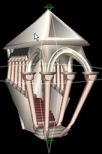Non-linear projection
Note: this is joint work with Karan Singh of the
University of Toronto.
The human vision system uses linear perspective locally
to resolve depth and shape. It is not, however, particularly good at
discerning global linear perspective - hence the difficulty
in learning to draw in true perspective. Artists have taken advantage
of this fact to give the illusion of depth while moving things around
on the image plane to produce pleasing 2D compositions. In fact, many
artists produce drawings that are perspectively incorrect, but
perceptually closer to what the eye actually sees.
The first approaches (1) (2) to non-linear
projection essentially allowed each object to have its own camera. Multiperspective
projection produces a panorama where the view point is allowed to change.
The most comprehensive system to date is Ryan, which
produces non-linear projections by combining two or more camera view
points in a reasonable way. This is, in essence, the inverse of a
free-form deformation - one can either consider each vertex in the
scene to have its own camera, or that the entire scene is deformed,
and then rendered with a single projection.
We are currently exploring alternative interfaces to non-linear
projection. Although Ryan is very general, it is almost too
general, and requires a great deal of hand-placement of cameras.
Our first approach to
this problem uses image-space constraints to
construct and control the cameras. This is, again, a very general
interface, but by defining the cameras in image-space, we make it much
easier to ensure that objects end up where we want them in the scene.
 On the opposite
end of the generality spectrum is curvi-linear perspective,
which produces a type of perspective distortion characterized by
projecting parallel lines in the model to sinusoids. The interface is
very simple, and since it's implemented in the GPU, fully interactive.
On the opposite
end of the generality spectrum is curvi-linear perspective,
which produces a type of perspective distortion characterized by
projecting parallel lines in the model to sinusoids. The interface is
very simple, and since it's implemented in the GPU, fully interactive.
Currently we are exploring other comprehensive interfaces for some
common non-linear projections, such as an "inside-out" and
"outside-in" projection.
See also camera interpolation and control.
Movies
- The Building with curved perspective, single camera.
- The Building with curved perspective, multiple cameras.
- A single screen-space constraint used to specify a non-linear projection.
- Multiple screen-space constraints used to specify a non-linear projection.
- The Sequence with no non-linear effects (OpenGL)
- The Sequence with no non-linear effects (Radiance)
- The Sequence with non-linear and color effects (OpenGL)
- The Sequence with non-linear and color effects (Radiance)
Papers
Students
 On the opposite
end of the generality spectrum is curvi-linear perspective,
which produces a type of perspective distortion characterized by
projecting parallel lines in the model to sinusoids. The interface is
very simple, and since it's implemented in the GPU, fully interactive.
On the opposite
end of the generality spectrum is curvi-linear perspective,
which produces a type of perspective distortion characterized by
projecting parallel lines in the model to sinusoids. The interface is
very simple, and since it's implemented in the GPU, fully interactive.